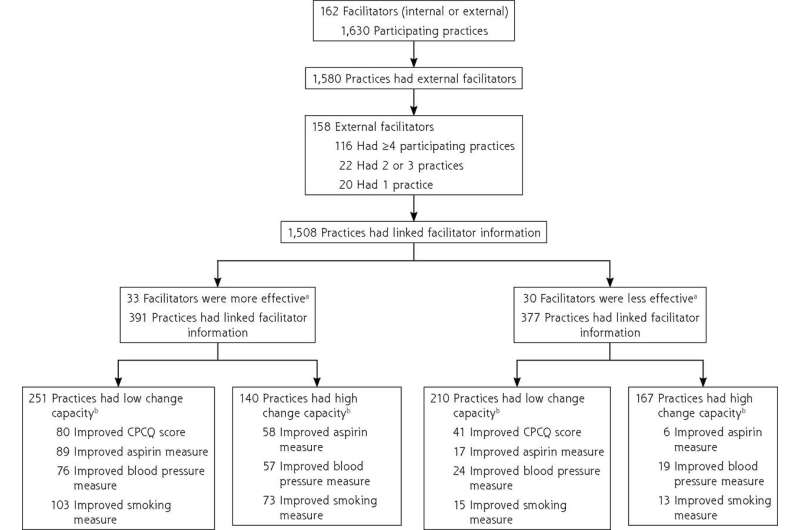Numbers of facilitators and practices. ABS = aspirin use for high-risk patients; CPCQ = Change Process Capability Questionnaire. Notes: Numbers of practices that improved on the CPCQ score and on the aspirin, blood pressure, and smoking measures are not mutually exclusive and add up to more than the total number of practices with high change capacity or low change capacity. a More effective: ≥75% of facilitator’s practices had improved CPCQ scores and/or ABS performance; less effective: <50% of facilitator’s practices had improved CPCQ scores and/or ABS performance. A total of 53 facilitators with 740 practices were neither more nor less effective, and were excluded from effectiveness analyses. b Assessed from baseline CPCQ score, dichotomized at the median value as high (score ≥11) or low (score <11). Credit: The Annals of Family Medicine (2022). DOI: 10.1370/afm.2847
Researchers analyzed data from a large-scale quality improvement initiative to determine which strategies for organizational change had the most impact on clinical outcomes.
One hundred and sixty-two facilitators were assigned to 1,630 small- to medium-sized primary care practices across 12 states to support the implementation of operational improvements aimed at improving cardiovascular disease outcomes.
High-performing facilitators—defined as facilitators who had 75% or more of their assigned practices show improvement across measured health outcomes—were found to:
- Adapt recommended processes to local clinics
- Address organizational resistance
- Encourage critical thinking
- Promote accountability
- Effectively communicate their role
The research was published in The Annals of Family Medicine.
More information: Shannon M. Sweeney et al, Effective Facilitator Strategies for Supporting Primary Care Practice Change: A Mixed Methods Study, The Annals of Family Medicine (2022). DOI: 10.1370/afm.2847
Journal information: Annals of Family Medicine
Provided by American Academy of Family Physicians





















